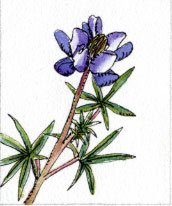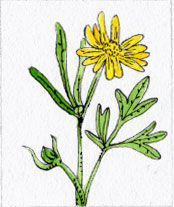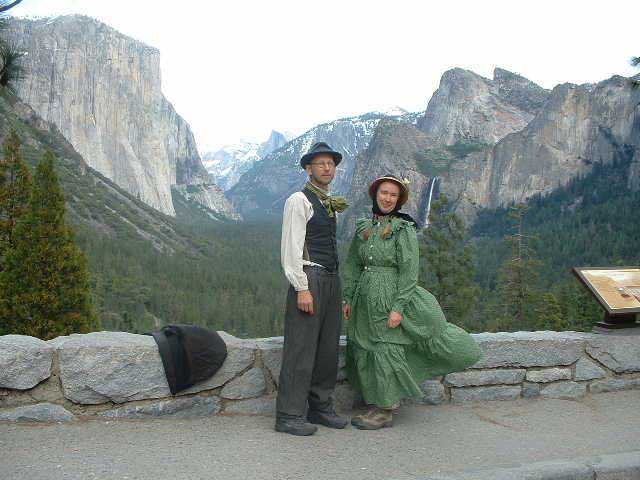Day 34 May 12
8 miles
Cascade Creek to Yosemite Valley
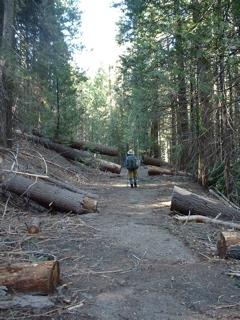
We crossed the main fork of Cascade Creek on an old bridge. Some of the railings were missing, perhaps knocked off by winters' storms. There was a great summer campsite on a knoll above the Cascade creek bridge with a view up to craggy granite spires. We lamented that we had a schedule to keep (as well as being out of food) and could not spend a few days in this river-sounding, piney-smelling, sunlit wilderness.
Though abandoned since the 1940s, the road was still in relatively good condition (except for the downed trees) and easy to follow. Old rock walls held the road in place on the steep hillsides, and we marveled that such beautiful masonry could also be so functional. We waltzed down a 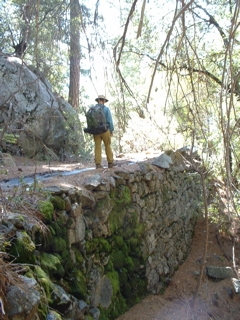
The trail kept alternating habitats: hot bare earth in the exposed chaparral, cool and needle-covered in the conifer forests, and warm crunchy-leaved and musty in the shade of the black oaks. We could see Silver Strand Fall across the valley. It is not labeled on current maps because it can only be seen from this no-longer-traveled road. We finally came to the famous "Oh My! Point": a huge vista of the valley featuring Bridalveil Fall in all its glory. An old metal railing was still there to keep us from falling as we stood on the precipice gazing at the distant fall and the valley below.
From Oh My! Point, to the valley floor, the trail was a boulderers' and rock hoppers' paradise. We crossed section after section of road that was gone, washed away or buried by sliding granite and now just a slope covered with rocks and boulders known as "talus." It was because of the constant 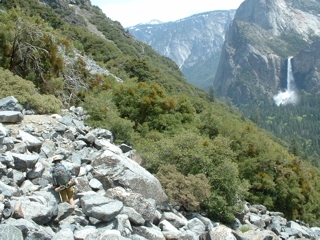
We kept getting new views of Bridalveil and realized why early visitors raved about it: the whole fall can be seen, from the water pouring over a lip of smooth granite to the misty billowing spray as the water crashes on the rocks at the bottom. The fall can be from the valley, from both Northside and Southside Drives, but the view is only partial because of the trees. Today visitors mostly remember Bridalveil for the heavy rain of mist that soaks them as they take the path from Southside Drive to the bottom of the fall.
Finally, we saw Half Dome, framed by El Capitan on the left and the south rim on the right, and knew we were getting close. We had not seen flowers since Bull Creek, but in sections of the trail between talus slopes we found red paint brush, pinedrops, snowplant and violets. As Muir 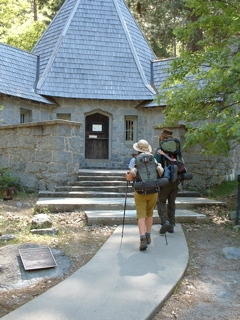
The old Big Oak Flat Road enters the valley floor west of El Capitan at the "wood lot"; a place where the park service stores downed trees to be used for campfires. Just beyond the wood lot was Ribbon Creek. Though the day was getting late, we were sweaty and hot. Muir-like, we threw off our clothes and baptized ourselves in its icy waters to celebrate our arrival. Then we made our way to the Le Conte Memorial Lodge for the official end of our walk. (The Le Conte Memorial is the Sierra Club's visitor center in the Yosemite Valley. With its library full of Muir-inspired books and its staff of nature-loving volunteer docents, it seemed the fitting place to end our journey.) The lodge's curator, Bonnie Gisel, officially welcomed us to Yosemite. John Olmsted and a few volunteers were also there and together they witnessed as we paid homage to John Muir for inspiring our trip by singing a song:
(To the tune of Oh Suzannah)
Oh, he came from Portage, Wisconsin
Though Scottish born was he,
Then traveled through the wilderness
The plant-life for to see.He rambled over Canada,
One thousand miles to the sea,
Then to California,
To see Yosemite.Chorus:
Oh, Mr. John Muir
You saved Yosemite
For all the people to enjoy
For all eternity.From old New York, to Panama,
To Frisco sailed he,
Alameda, San Jose,
Then down to Gilroy(ee)Went o'er Pacheco with its flowers
And crossed at Hill's Ferry,
Hopeton, Snelling, Coulterville,
Then to Yosemite.Chorus
I had a dream the other night
When everything was still.
Dreamed I saw old John Muir,
Coming o'er the hill.A plant press was on his back,
A tear was in his eye.
Said I saw Yosemite,
How could I help but cry?Chorus
Second Chorus:
Oh Mr. John Muir
Your life inspired us,
We walked up to Yosemite,
Next time we'll take a bus!
